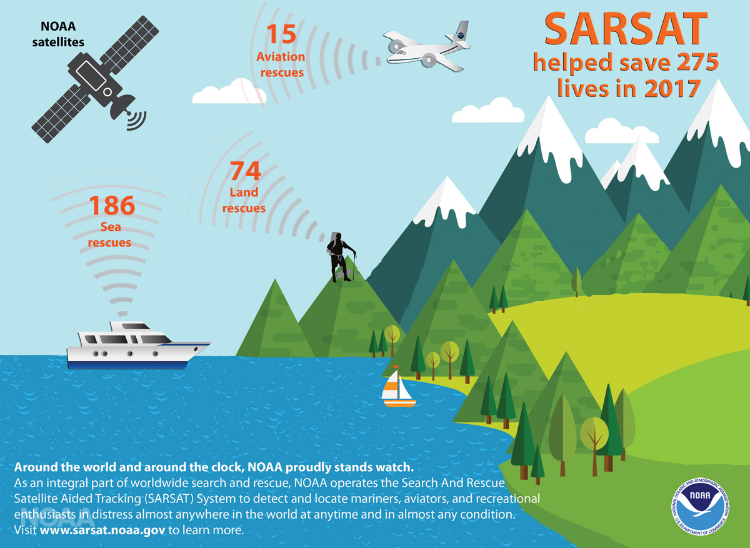#406DAY18 Focuses on Emergency Beacons
#406DAY18 is an international social media effort to raise awareness of the life-saving 406 MHz technology used on emergency beacons, which are part of the international Search and Rescue Satellite Aided Tracking System, or COSPAS-SARSAT.
In 2017, a total of 275 people were rescued within the United States and its surrounding waters, thanks largely to National Oceanic and Atmospheric Agency satellites, which are part of SARSAT. This system uses a sprawling network of satellites to detect and locate 406 MHz distress signals quickly from emergency beacons aboard aircraft and boats and from handheld personal locator beacons, or PLBs.
When an NOAA satellite pinpoints the location of a distress signal, the information is relayed to the SARSAT Mission Control Center at NOAA’s Satellite Operations Facility in Suitland, Maryland. From there, the information is quickly sent to a rescue coordination center, operated by either the U.S. Air Force for land rescues or the U.S. Coast Guard for water rescues.
The goals of #406DAY18 include encouraging:
- 406 MHz beacon owners to share photos on their social media accounts, displaying what having a beacon frees them to do;
- Survivors who used a 406 MHz beacon to celebrate their second lease on life and thank the search and rescue team that responded to their emergency call;
- Beacon owners to update their information in the NOAA SARSAT Beacon Registration Database;
- Beacon owners to conduct self-tests of their devices, according to the manufacturer’s instructions.
All beacon owners are reminded that beacon registration is free, easy and required by law. Federal law requires that all emergency position indicating emergency position indicating radio beacons (EPIRBs), personal locator beacons (PLBs) and emergency locator transmitters (ELTs) be registered in the NOAA SARSAT Beacon Registration Database. This system is free to all owners of EPIRBs, PLBs and ELTs.
When beacon user/vessel or aircraft owner information changes, it should be updated online or by contacting the NOAA SARSAT Beacon Registration Database at 1-888-212-SAVE (7283). This information is protected and only available to authorized rescue personnel if a distress activation occurs.
Beacon registration is valid for two years; owners are required to validate their beacon information every two years to ensure currency of their contact information. Up-to-date beacon owner information allows for the most efficient use of SAR resources upon beacon activation and can decrease rescue response time during distress situations.
If your EPIRB or PLB is accidentally activated, contact the U.S. Coast Guard at 1-855-406-USCG (8724) and provide them with the beacon’s ID to cancel the false alert. If your ELT or PLB is accidentally activated, contact the U.S. Air Force Rescue Coordination Center at 1-800-851-3051 and provide them with the beacon’s ID to cancel the false alert.
Search and rescue personnel begin responding immediately to every activation of a 406 MHz SARSAT beacon. That response will stop only if it has been proven that the activation was not a distress alert. Every false alert has the potential to put rescuers in harm’s way and waste limited search and rescue resources. Cancellation of false alerts helps protect SAR personnel who would be activated during an actual emergency, and ensures valuable resources are available to respond to actual distress cases.


